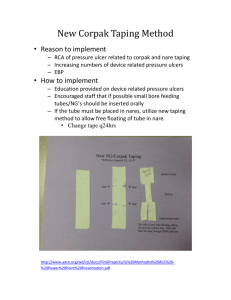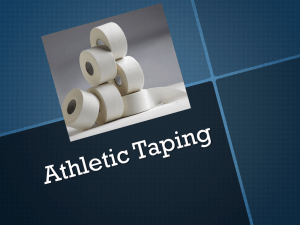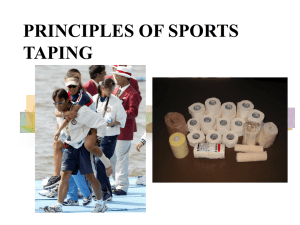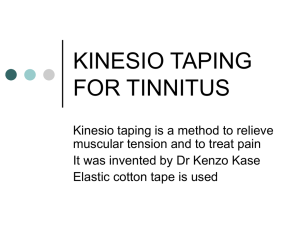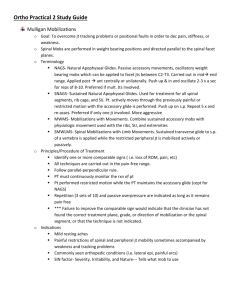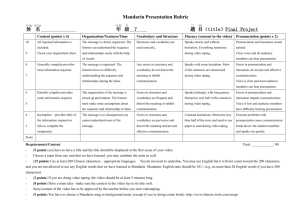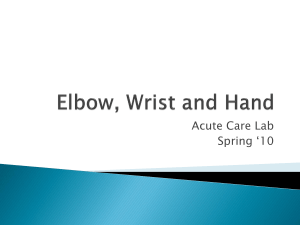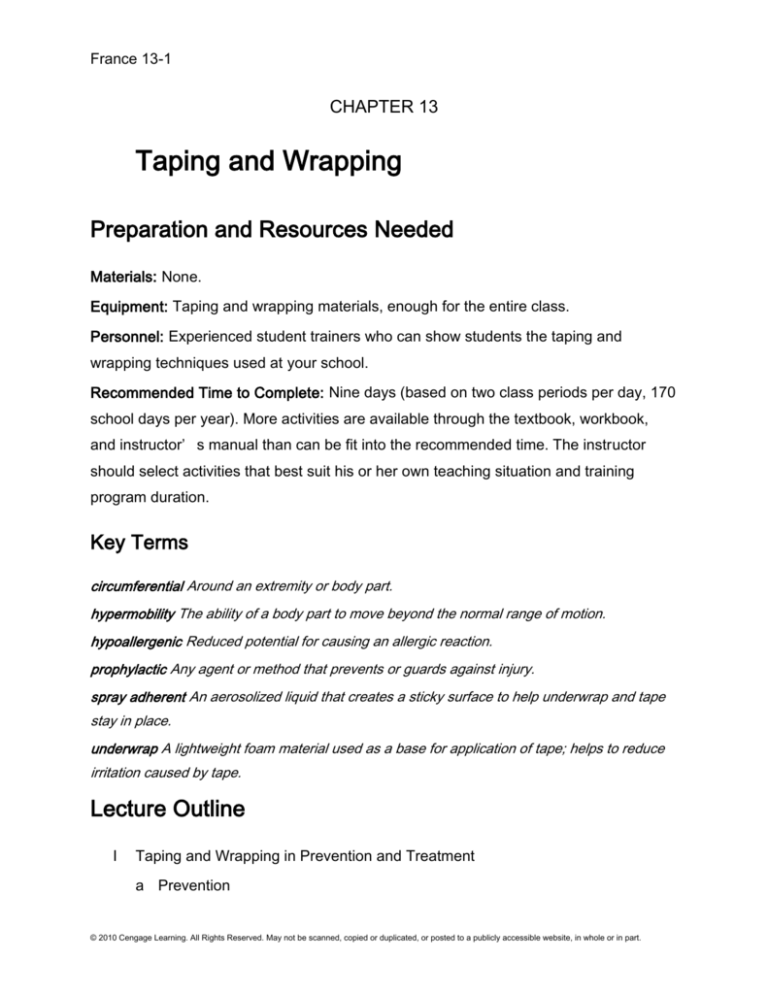
France 13-1
CHAPTER 13
Taping and Wrapping
Preparation and Resources Needed
Materials: None.
Equipment: Taping and wrapping materials, enough for the entire class.
Personnel: Experienced student trainers who can show students the taping and
wrapping techniques used at your school.
Recommended Time to Complete: Nine days (based on two class periods per day, 170
school days per year). More activities are available through the textbook, workbook,
and instructor’ s manual than can be fit into the recommended time. The instructor
should select activities that best suit his or her own teaching situation and training
program duration.
Key Terms
circumferential Around an extremity or body part.
hypermobility The ability of a body part to move beyond the normal range of motion.
hypoallergenic Reduced potential for causing an allergic reaction.
prophylactic Any agent or method that prevents or guards against injury.
spray adherent An aerosolized liquid that creates a sticky surface to help underwrap and tape
stay in place.
underwrap A lightweight foam material used as a base for application of tape; helps to reduce
irritation caused by tape.
Lecture Outline
I
Taping and Wrapping in Prevention and Treatment
a Prevention
© 2010 Cengage Learning. All Rights Reserved. May not be scanned, copied or duplicated, or posted to a publicly accessible website, in whole or in part.
France 13-2
i
Used for additional protection
b Treatment
i
c
Used for new and healing injuries
Prior evaluation provides information to guide in selection
d Primary purpose
i
Additional support, stability, and compression
Key Concept
The primary purpose of taping and wrapping is to provide additional support, stability, and
compression for an affected body part. Taping can be used as a preventive measure or as
protection for new or healing injuries.
II Supplies Commonly Used in Taping
a Adhesive athletic tape
i
Most commonly used is 1-1/2 inches wide and 15 feet long
ii
Hypoallergenic
iii Cotton-backed with an adhesive designed to withstand temperature
changes
iv Torn easily if it is held firmly on each side and pulled away at an angle
b Tape underwrap
i
Helps eliminate irritation from repeated taping
ii
Made of a light foam
iii Typically 2-3/4 inches wide by 30 yards long
iv Promotes comfort
c
Spray adherent
i
Helps adhesive tape or underwrap adhere
ii
The less the tape slips, the more protection and less chafing
d Heel and lace pads
i
Help prevent pinching and blistering in friction-prone areas
© 2010 Cengage Learning. All Rights Reserved. May not be scanned, copied or duplicated, or posted to a publicly accessible website, in whole or in part.
France 13-3
e Tape removal tools
i
Specialized scissors or tape-cutting devices
ii
Designed to slip under tape and underwrap, and quickly slice through it
with no irritation
Key Concept
Supplies needed for taping and wrapping include spray adhesives, underwrap, tape, foam
paddings, and tape-removing tools.
III Prophylactic Taping of the Ankle
a Most common use for athletic tape
b Before ankle is taped, athlete’ s foot should be checked for:
i
Blisters
ii
Abrasions
iii Cuts
iv Athlete’ s foot (fungal infections)
IV Basic Ankle Taping
a Demonstration figures
V Compression Wrap of the Ankle
a Used to control swelling and inflammation
VI Low-Dye Taping
a Helps to improve foot biomechanics by keeping the athlete from
overpronating
VII Turf-Toe Taping
a Shoe grips hard on surface and sticks
i
VIII
Causes body weight to go forward and bend the toe upward
Achilles-Tendon Taping
a Relieves strain and prevents overstretching
IX Shin-Splint Taping
© 2010 Cengage Learning. All Rights Reserved. May not be scanned, copied or duplicated, or posted to a publicly accessible website, in whole or in part.
France 13-4
a Circumferential elastic taping provides gentle compression
X Wrist Taping
a [Demonstration figures]
XI Thumb Taping
a [Demonstration figures]
XII Finger Support
a [Demonstration figures]
XIII
Elbow Taping
a [Demonstration figures]
XIV
Groin Wrap
a [Demonstration figures]
XV Hip Flexor Wrap
a [Demonstration figures]
XVI
Thigh Compression Wrap
a [Demonstration figures]
XVII
Conclusion
a Taping and wrapping are important skills
i
Primary purpose is to provide additional support, stability, and
compression
ii
To become proficient, the ATC must have good working knowledge of
anatomy and biomechanics
Coordination, skill, and practice are also required
Lesson Plans and Teaching Strategies
Follow the lecture outline to present material to students, using a variety of teaching
strategies described in the Instructional Strategies, such as modified lecture and
cooperative/collaborative learning.
© 2010 Cengage Learning. All Rights Reserved. May not be scanned, copied or duplicated, or posted to a publicly accessible website, in whole or in part.
France 13-5
The best way to learn taping and wrapping techniques is to practice them under the
supervision of experts. Experienced student trainers are the experts, and they can
teach students the proper techniques, as well as coach them as they practice
(preferably on other students in the class). The ultimate test of success, though, is
performing proper taping and wrapping for the instructor of the course.
Since this is the major activity of student trainers for all sports, time spent in this
chapter perfecting the procedures will be well worth it. Practice should not stop with the
end of the chapter, though. Perfecting taping and wrapping techniques, even in real
situations with real athletes, should go on for the rest of the course (and into future
years of student training).
Answers to Student Exercises
Textbook Review Questions
1. The purpose of taping and wrapping is to provide additional support, stability,
and compression for an affected body part. It can be used to prevent injury,
prevent further injury, and protect new or healing wounds.
2. Common supplies needed include spray adhesives, underwrap, tape, foam
padding, and tape-removing tools.
3. Athletic tape sizes range from 1/2” to 6” in width, the most commonly used
being 1-1/2” width in 15-foot rolls.
4. Tape materials that cause allergic reactions will do more harm than good.
Hypoallergenic tape uses materials that are proven to cause few allergic
reactions.
5. Hold tape firmly on both sides of the potential tear and pull away at an angle,
forcing fibers of the tape to break.
6. Spray adherent helps keep the adhesive tape and underwrap adhered to the
skin, providing more protection.
7. These are friction-prone areas, and the heel and lace pads, especially with a
lubricant ointment, reduce the friction to help prevent pinching and blistering.
© 2010 Cengage Learning. All Rights Reserved. May not be scanned, copied or duplicated, or posted to a publicly accessible website, in whole or in part.
France 13-6
8. Low-dye taping improves foot biomechanics by keeping the athlete’ s foot from
overpronating (rotating inward), helping prevent plantar fasciitis, heel pain, shin
splints, and stress fractures.
9. People with hypermobile joints may have greater-than-average joint flexibility,
deeper-than-normal cavities where bones fit together, or degenerative joint
diseases.
10. Thigh compression wrap helps control the extent of intramuscular bleeding when
an athlete receives a severe blow to the thigh.
Workbook Vocabulary Review
Matching
1. F
2. B
3. A
4. E
5. C
6. D
Workbook Quiz
1. D
2. C
3. A
4. B
5. C
6. B
7. D
8. A
9. B
10. C
© 2010 Cengage Learning. All Rights Reserved. May not be scanned, copied or duplicated, or posted to a publicly accessible website, in whole or in part.
France 13-7
Critical Thinking
1. Before any tape or wraps are applied, a certified athletic trainer or team physician
should complete a full assessment of the athlete’ s injury. This evaluation provides
information that guides the medical staff in the proper selection of taping, wrapping,
or bracing. Before the ankle is taped, the foot should be checked for blisters,
abrasions, cuts, and athlete’ s foot (fungal infections). When an athlete sprains an
ankle, it will be necessary to control swelling and inflammation. A compression wrap
with a felt horseshoe puts gentle pressure on the areas of the ankle where swelling
is likely to occur. Compression wraps can be worn for up to 24 hours, or more if
instructed. Prophylactic taping will protect the ankle from additional injury. If the
injury is a very mild sprain, proper taping will allow safe return to play.
© 2010 Cengage Learning. All Rights Reserved. May not be scanned, copied or duplicated, or posted to a publicly accessible website, in whole or in part.

